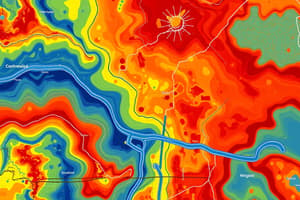Podcast
Questions and Answers
What is the primary focus of the study of climatology?
What is the primary focus of the study of climatology?
- Examining the Earth's climate and its variations (correct)
- Studying the Earth's geography
- Analyzing the Earth's atmosphere
- Understanding Earth's oceans
Which of the following is a characteristic of urbanization?
Which of the following is a characteristic of urbanization?
- Limited infrastructure
- Low population density
- Economic and social diversity (correct)
- Rural way of life
What is the term for the process of creating new oceanic crust at mid-ocean ridges?
What is the term for the process of creating new oceanic crust at mid-ocean ridges?
- Continental drift
- Plate collision
- Seafloor spreading (correct)
- Seafloor erosion
What is the term for the outermost solid layer of Earth?
What is the term for the outermost solid layer of Earth?
What is a result of urbanization?
What is a result of urbanization?
What is the term for the movement of tectonic plates past each other?
What is the term for the movement of tectonic plates past each other?
What is the term for the process of the Earth's climate becoming warmer?
What is the term for the process of the Earth's climate becoming warmer?
What is the stage of urbanization where urban areas experience stabilization and redevelopment?
What is the stage of urbanization where urban areas experience stabilization and redevelopment?
Flashcards are hidden until you start studying
Study Notes
Climatology
- Study of Earth's climate and its variations
- Examines atmospheric and oceanic factors that influence climate
- Key components:
- Temperature
- Precipitation
- Atmospheric circulation
- Ocean currents
- Types of climates:
- Tropical
- Desert
- Temperate
- Polar
- Climate change:
- Global warming
- Greenhouse effect
- Human impact (e.g., deforestation, burning fossil fuels)
Urbanization
- Process of population growth and migration to urban areas
- Characteristics:
- High population density
- Economic and social diversity
- Developed infrastructure (e.g., transportation, housing, utilities)
- Urbanization stages:
- Urban growth: Increase in population and economic activity
- Urbanization: Shift from rural to urban way of life
- Urban maturity: Stabilization and redevelopment of urban areas
- Effects of urbanization:
- Economic growth
- Social changes (e.g., increased diversity, cultural exchange)
- Environmental concerns (e.g., pollution, resource depletion)
Plate Tectonics
- Theory explaining Earth's surface processes and features
- Key concepts:
- Lithosphere: Outermost solid layer of Earth
- Tectonic plates: Large, rigid sections of lithosphere
- Plate boundaries: Areas where plates interact (e.g., converge, diverge, transform)
- Types of plate boundaries:
- Divergent: Plates moving apart (e.g., mid-ocean ridges)
- Convergent: Plates moving together (e.g., subduction zones)
- Transform: Plates sliding past each other (e.g., fault lines)
- Processes:
- Seafloor spreading: Creation of new oceanic crust
- Continental drift: Movement of continents over time
- Earthquakes: Release of energy at plate boundaries
Climatology
- The study of Earth's climate involves examining atmospheric and oceanic factors that influence climate.
- Key components of climate include temperature, precipitation, atmospheric circulation, and ocean currents.
- There are four main types of climates: tropical, desert, temperate, and polar.
- Climate change is a significant concern, driven by global warming and the greenhouse effect, and exacerbated by human activities such as deforestation and burning fossil fuels.
Urbanization
- Urbanization is the process of population growth and migration to urban areas, characterized by high population density, economic and social diversity, and developed infrastructure.
- The three stages of urbanization are urban growth, urbanization, and urban maturity.
- Urbanization can drive economic growth and lead to social changes, such as increased diversity and cultural exchange, but also raises environmental concerns like pollution and resource depletion.
Plate Tectonics
- The theory of plate tectonics explains Earth's surface processes and features, with the lithosphere being the outermost solid layer of Earth.
- The lithosphere is broken into large, rigid sections called tectonic plates, which interact at plate boundaries.
- There are three types of plate boundaries: divergent (where plates move apart), convergent (where plates move together), and transform (where plates slide past each other).
- Processes driven by plate tectonics include seafloor spreading, continental drift, and earthquakes.
Studying That Suits You
Use AI to generate personalized quizzes and flashcards to suit your learning preferences.




